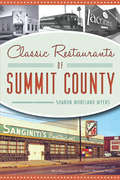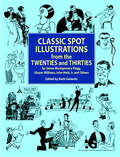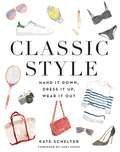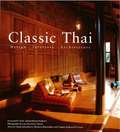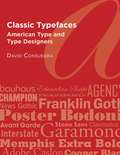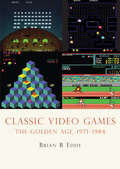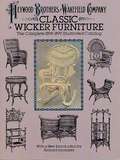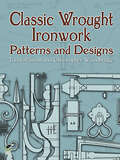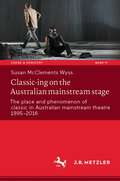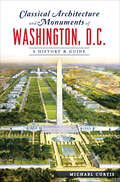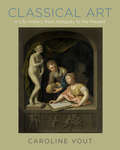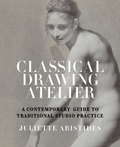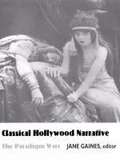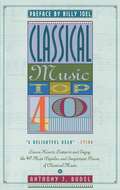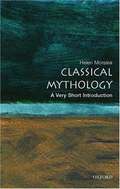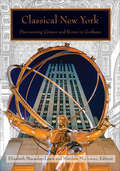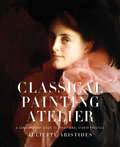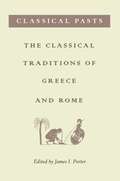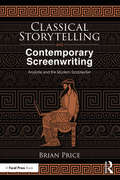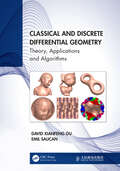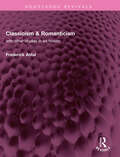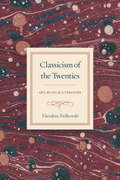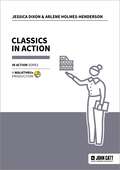- Table View
- List View
Classic Restaurants of Summit County (American Palate)
by Sharon Moreland Myers Images courtesy of the Akron Beacon Journal--Summit Memory ProjectAkron and Summit County's classic hot spots have satisfied palates since the early twentieth century. Akron alone could sit up to thirty thousand people at once during the golden age of the '50s and '60s. Marcel's made a name for itself with its scampi, and Icaomini's became synonymous with lobster. Ladd's dished crowd-pleasing coney dogs, and Yanko's sliced up its mouthwatering shish kabobs. Digging up vintage images and recipes, author Sharon Myers leads readers on a delectable trip down memory lane to the area's most renowned and cherished eateries.
Classic Spot Illustrations from the Twenties and Thirties: by James Montgomery Flagg, Gluyas Williams, John Held, Jr., et al (Dover Pictorial Archive)
by Herb GalewitzAt the beginning of the 20th century, Judge (established in 1881) and Life (1883), together with Puck, were the premier humor magazines in the United States. Puck disappeared in 1918. But, by the 1920s and early '30s, Life and Judge had achieved enormous popularity. Not until the establishment of the New Yorker in 1925 was their position seriously challenged. This huge readership was due primarily to the magazines' cartoons. From politics to domestic bliss, childhood to boardroom, breadline to kick line -- no subject was safe from the humorists' pens.This rich source of more than 700 royalty-free images from the '20s and '30s represents the very best from those legendary magazines. You'll find black-and-white illustrations from Charles Dana Gibson, James Montgomery Flagg, Reginald Bathurst Birch, John Held, Jr., Russell Patterson, A. B. Frost, Rube Goldberg, Art Young, Dr. Seuss, and others.
Classic Style: Hand It Down, Dress It Up, Wear It Out
by Andy Spade Kate SchelterA gorgeously illustrated guide to "the classics": the essential clothes, accessories, beauty products, and timeless everyday objects that define your personal style.In CLASSIC STYLE, fashion expert and illustrator Kate Schelter curates a collection of more than 150 iconic, essential classics-- clothes, accessories, beauty products, objects, and travel items that exemplify great design, simplicity, and timeless style. Balancing the trend toward minimalism with a dose of charm and personality, Kate shows you how to develop (and celebrate!) your own style by following an easy mantra: buy less, buy better, reinvent what you already have, and own your look. Now in her first book, she guides readers through these principles in a mix of stunning watercolor illustrations, stories, memories, quotes, and advice from a collection of friends and mentors in the fashion world. A visual gem, CLASSIC STYLE will inspire you to pare down those stuffed closets and storage units, find joy in simplicity and usefulness, and rediscover the one thing that is truly essential to personal style--you!
Classic Thai
by Luca Invernizzi Tettoni Chami Jotisalikorn Virginia Di Crocco Phuthorn BhumadhonFrom the glittering chedis of Bangkok's Grand Palace to the rustic simplicity of village dwellings, Thailand offers a rich diversity of art, architecture and design. Classic Thai seeks to define the unique characteristics of Thai style, be it through the country's rich arts and crafts tradition, in its plentiful temples and palaces, or in a contemporary home. Photographed entirely on location, Classic Thai is an indispensable guide to the wonders of Thailand.
Classic Typefaces: American Type and Type Designers
by David ConsuegraGraphic designers will enrich their understanding of American type design and type designers with this unique and extensive reference. The fascinating history of type in America is chronicled through the typefaces and biographies of sixty-two of the most influential type designers, including Linn Boyd Benton, Morris Fuller Benton, and Darius Wells, and through the description and history of nine American type foundries. Complete with samples of 334 different typefaces, and 700 black-and-white illustrations, this eye-popping reference reveals the expansive contribution America has made to the world of type design.
Classic Video Games
by Brian EddyIn the early 1970s, video arcade games sprung to life with the advent of Pong and other coin-operated games. Within just a few short years, if you had a quarter, you could go to the video arcade and play Space Invaders, Asteroids, or Pac-Man. If you were lucky enough to have an Atari system hooked up to your television, you could play Frogger or Galaga at home. By the early 1980s, arcade and video games were entrenched as a pop culture phenomenon, with players spending hours in arcades racking up as many points as possible. Arcade games were everywhere: restaurants, bowling alleys, department stores, grocery stores--anywhere that could accommodate a three-foot by five-foot machine. But, just as soon as the phenomenon began, it morphed into something else with the advent of hand-held games and more sophisticated home-gaming systems. Brian Eddy, former executive director, producer, and programmer for Midway Games, traces the evolution of arcade video games in Classic Video Games, giving readers an inside look at the stratospheric rise--and collapse--of the industry. Readers will reminisce about their favorite games, such as Centipede, Ms. Pac-Man, Tron, and Star Wars as they relive the glory days of the classic video game rage of the 1970s and 1980s.
Classic Wicker Furniture
by Heywood BrothersComplete reproduction of rare 1897 premiere issue of most famous wicker company catalog; probably finest primary source. Includes rocking chairs, armchairs, divans, tables, cabinets, etc. Over 400 illustrations. Indispensable reference for antique dealers, collectors, Americana buffs.
Classic Wrought Ironwork Patterns and Designs
by Tunstall Small Christopher WoodbridgeThe splendid illustrations in this book represent outstanding examples of the ironworker's art. Spanning some 600 years, the meticulously rendered black-and-white line designs depict authentic hinges, railings, casement fasteners, latches, handles, and other ornamental elements selected from a wide range of styles and structures from the twelfth-century to the eighteenth. A List of Plates provides approximate dates of all illustrated examples.An invaluable source of inspiration for ironworkers attempting to recapture the beauty and craftsmanship of metalwork created by early masters, these royalty-free, nearly life-size patterns (reduced by about 20 percent for this edition) will also be of value to artists, architects, and designers.
Classic-ing on the Australian mainstream stage: The place and phenomenon of classic in Australian mainstream theatre 1995-2016 (Szene & Horizont. Theaterwissenschaftliche Studien #11)
by Susan McClements WyssThis book evaluates classic drama as an active creation. To classic is a complex theatrical practice that animates program choice, casting and staging, audience reception and critical response. Analysis of six distinct examples of pre-determined and self-nominated classic productions on the Australian mainstage is informed by postcolonial theory, specifically the settler dilemma of Indigenous cultural authority. What happens to the political edge of postcolonial aspiration within the status of classic? Close consideration of staging and casting, theatre historical perspectives, and interviews with key artists, expands the concept of classic as a dimension of theatrical and not only of dramatic reception. This book responds to a polarised debate that focused on auteur directors and the relative value of new vs classic plays. Rather than adopting a position, the study undertakes a deeper assessment of the phenomenon and place of the dramatic classic in Australian mainstream theatre.
Classical Architecture and Monuments of Washington, D.C.: A History & Guide (History And Guide Ser.)
by Michael CurtisA look at the statues, monuments, and buildings of the classically designed capital city—from the National Mall to Colonial Alexandria. Classical design formed our nation&’s capital. The soaring Washington Monument, the columns of the Lincoln Memorial and the spectacular dome of the Capitol Building speak to the founders&’ comprehensive vision of our federal city. Learn about the L&’Enfant and McMillan plans for Washington, D.C., and how those designs are reflected in two hundred years of monuments, museums and representative government. View the statues of our Founding Fathers with the eye of a sculptor and gain insight into the criticism and controversies of modern additions to Washington&’s monumental structure. Author Michael Curtis guides this tour of the heart of the District of Columbia.
Classical Art: A Life History from Antiquity to the Present
by Caroline VoutHow did the statues of ancient Greece wind up dictating art history in the West? How did the material culture of the Greeks and Romans come to be seen as "classical" and as "art"? What does "classical art" mean across time and place? In this ambitious, richly illustrated book, art historian and classicist Caroline Vout provides an original history of how classical art has been continuously redefined over the millennia as it has found itself in new contexts and cultures. All of this raises the question of classical art's future.What we call classical art did not simply appear in ancient Rome, or in the Renaissance, or in the eighteenth-century Academy. Endlessly repackaged and revered or rebuked, Greek and Roman artifacts have gathered an amazing array of values, both positive and negative, in each new historical period, even as these objects themselves have reshaped their surroundings. Vout shows how this process began in antiquity, as Greeks of the Hellenistic period transformed the art of fifth-century Greece, and continued through the Roman empire, Constantinople, European court societies, the neoclassical English country house, and the nineteenth century, up to the modern museum.A unique exploration of how each period of Western culture has transformed Greek and Roman antiquities and in turn been transformed by them, this book revolutionizes our understanding of what classical art has meant and continues to mean.
Classical Drawing Atelier: A Contemporary Guide to Traditional Studio Practice
by Juliette AristidesAteliers have produced the greatest artists of all time--and now that educational model is experiencing a renaissance. These studios, a return to classical art training, are based on the nineteenth-century model of teaching artists by pairing them with a master artist over a period of years. Students begin by copying masterworks, then gradually progress to painting as their skills develop. Classical Drawing Atelier is an atelier in a book--and the master is Juliette Aristides, a classically trained artist. On every page, Aristides uses the works of works of Old Masters and today's most respected realist artists to demonstrate and teach the principles of realist drawing and painting, taking students step by step through the learning curve yet allowing them to work at their own pace. Unique and inspiring, Classical Drawing Atelier is a serious art course for serious art students.From the Hardcover edition.
Classical Hollywood Narrative: The Paradigm Wars
by Jane M. GainesSince the 1970s film studies has been dominated by a basic paradigm--the concept of classical Hollywood cinema--that is, the protagonist-driven narrative, valued for the way it achieves closure by neatly answering all of the enigmas it raises. It has been held to be a form so powerful that its aesthetic devices reinforce gender positions in society. In a variety of ways, the essays collected here--representing the work of some of the most innovative theorists writing today--challenge this paradigm.Significantly expanded from a special issue of South Atlantic Quarterly (Spring 1989), these essays confront the extent to which formalism has continued to dominate film theory, reexamine the role of melodrama in cinematic development, revise notions of "patriarchal cinema," and assert the importance of television and video to cinema studies. A range of topics are discussed, from the films of D. W. Griffith to sexuality in avant-garde film to television's Dynasty.Contributors. Rick Altman, Richard Dienst, Jane Feuer, Jane Gaines, Christine Gledhill, Miriam Hansen, Norman N. Holland, Fredric Jameson, Bill Nichols, Janey Staiger, Chris Straayer, John O. Thompson
Classical Music Top 40
by Anthony RudelIn this informal and informative guide, Rudel leads listeners through the 40 most essential and popular compositions from the Four Seasons to Rhapsody in Blue, explaining the musical structure of each passage and highlighting special themes or elements to listen for as the music continues.
Classical Mythology: A Very Short Introduction
by Helen MoralesFrom Zeus and Europa, to Diana, Pan, and Prometheus, the myths of ancient Greece and Rome seem to exert a timeless power over us. But what do those myths represent, and why are they so enduringly fascinating? Why do they seem to be such a potent way of talking about our selves, our origins, and our desires? This imaginative and stimulating Very Short Introduction goes beyond a simple retelling of the stories to explore the rich history and diverse interpretations of classical mythology. It is a wide-ranging account, examining how classical myths are used and understood in both high art and popular culture, taking the reader from the temples of Crete to skyscrapers in New York, and finding classical myths in a variety of unexpected places: from Arabic poetry and Hollywood films, to psychoanalysis, the Bible, and New Age spiritualism.
Classical New York: Discovering Greece and Rome in Gotham
by Francis Morrone Elizabeth Macaulay-Lewis Matthew McGowan Elizabeth Bartman Maryl B. Gensheimer Margaret Malamud Allyson McDavid Jon Ritter Jared SimardDuring the rise of New York from the capital of an upstart nation to a global metropolis, the visual language of Greek and Roman antiquity played a formative role in the development of the city’s art and architecture. This compilation of essays offers a survey of diverse reinterpretations of classical forms in some of New York’s most iconic buildings, public monuments, and civic spaces.Classical New York examines the influence of Greco-Roman thought and design from the Greek Revival of the late eighteenth and early nineteenth centuries through the late-nineteenth-century American Renaissance and Beaux Arts period and into the twentieth century’s Art Deco. At every juncture, New Yorkers looked to the classical past for knowledge and inspiration in seeking out new ways to cultivate a civic identity, to design their buildings and monuments, and to structure their public and private spaces.Specialists from a range of disciplines—archaeology, architectural history, art history, classics, and history— focus on how classical art and architecture are repurposed to help shape many of New York City’s most evocative buildings and works of art. Federal Hall evoked the Parthenon as an architectural and democratic model; the Pantheon served as a model for the creation of Libraries at New York University and Columbia University; Pennsylvania Station derived its form from the Baths of Caracalla; and Atlas and Prometheus of Rockefeller Center recast ancient myths in a new light during the Great Depression.Designed to add breadth and depth to the exchange of ideas about the place and meaning of ancient Greece and Rome in our experience of New York City today, this examination of post-Revolutionary art, politics, and philosophy enriches the conversation about how we shape space—be it civic, religious, academic, theatrical, or domestic—and how we make use of that space and the objects in it.
Classical Ornament
by C. ThierryThis rare collection, originally published in Germany during the 1860s, presents a wealth of designs from temples and other buildings of ancient Greece and Rome. The seventy-one black-and-white plates include mythological creatures, floral borders, engraved columns and capitals, and many other decorative motifs, all rendered with the delicacy and precision characteristic of classical ornament.A valuable source of royalty-free illustrations, this compilation abounds in images that will provide a touch of authenticity to any graphic project related to ancient Greece or Rome. Fine art aficionados, crafters and designers, and collectors of classical art will rejoice in this inexpensive volume and its hard-to-find artwork.
Classical Painting Atelier: A Contemporary Guide to Traditional Studio Practice
by Juliette AristidesWant to paint more like Manet and less like Jackson Pollock? Students of art hailedClassical Drawing Atelier, Juliette Aristides’s first book, as a dynamic return to the atelier educational model. Ateliers, popular in the nineteenth century, teach emerging artists by pairing them with a master artist over a period of years. The educational process begins as students copy masterworks, then gradually progress to painting as their skills develop. The many artists at every level who learned fromClassical Drawing Atelierhave been clamoring for more of this sophisticated approach to teaching and learning. InClassical Painting Atelier,Aristides, a leader in the atelier movement, takes students step-by-step through the finest works of Old Masters and today’s most respected realist artists to reveal the principles of creating full-color realist still lifes, portraits, and figure paintings. Rich in tradition, yet practical for today’s artists,Classical Painting Atelieris ideal for serious art students seeking a timeless visual education.
Classical Pasts: The Classical Traditions of Greece and Rome
by James I. PorterThe term "classical" is used to describe everything from the poems of Homer to entire periods of Greek and Roman antiquity. But just how did the concept evolve? This collection of essays by leading classics scholars from the United States and Europe challenges the limits of the current understanding of the term. The book seeks not to arrive at a final definition, but rather to provide a cultural history of the concept by exploring how the meanings of "classical" have been created, recreated, and rejected over time. The book asks questions that have been nearly absent from the scholarly literature. Does "classical" refer to a specific period of history or to the artistic products of that time? How has its definition changed? Did those who lived in classical times have some understanding of what the term "classical" has meant? How coherent, consistent, or even justified is the term? The book's introduction provides a generous theoretical and historical overview. It is followed by eleven chapters in which the contributors argue for the existence not of a single classical past, but of multiple, competing classical pasts. The essays address a broad range of topics--Homer and early Greek poetry and music, Isocrate, Hellenistic and Roman art, Cicero and Greek philosophy, the history of Latin literature, imperial Greek literature, and more. The most up-to-date and challenging treatment of the topic available, this collection will be of lasting interest to students and scholars of ancient and modern literature, art, and cultural history.
Classical Storytelling and Contemporary Screenwriting: Aristotle and the Modern Scriptwriter
by Brian PriceSince we first arrived on the planet, we’ve been telling each other stories, whether of that morning’s great saber-tooth tiger hunt or the latest installment of the Star Wars saga. And throughout our history, despite differences of geography or culture, we’ve been telling those stories in essentially the same way. Why? Because there is a RIGHT way to tell a story, one built into our very DNA. In his seminal work Poetics, Aristotle identified the patterns and recurring elements that existed in the successful dramas of his time as he explored precisely why we tell stories, what makes a good one, and how to best tell them. In Classical Storytelling and Contemporary Screenwriting, Brian Price examines Aristotle’s conclusions in an entertaining and accessible way and then applies those guiding principles to the most modern of storytelling mediums, going from idea to story to structure to outline to final pages and beyond, covering every relevant screenwriting topic along the way. The result is a fresh new approach to the craft of screenwriting—one that’s only been around a scant 2,500 years or so—ideal for students and aspiring screenwriters who want a comprehensive step-by-step guide to writing a successful screenplay the way the pros do it.
Classical Traditions In Science Fiction
by Benjamin Eldon Stevens Brett M. Rogersor all its concern with change in the present and future, science fiction is deeply rooted in the past and, surprisingly, engages especially deeply with the ancient world. Indeed, both as an area in which the meaning of "classics" is actively transformed and as an open-ended set of texts whose own 'classic' status is a matter of ongoing debate, science fiction reveals much about the roles played by ancient classics in modern times. Classical Traditions in Science Fiction is the first collection in English dedicated to the study of science fiction as a site of classical receptions, offering a much-needed mapping of that important cultural and intellectual terrain.
Classical and Discrete Differential Geometry: Theory, Applications and Algorithms
by David Xianfeng Gu Emil SaucanThis book introduces differential geometry and cutting-edge findings from the discipline by incorporating both classical approaches and modern discrete differential geometry across all facets and applications, including graphics and imaging, physics and networks. With curvature as the centerpiece, the authors present the development of differential geometry, from curves to surfaces, thence to higher dimensional manifolds; and from smooth structures to metric spaces, weighted manifolds and complexes, and to images, meshes and networks. The first part of the book is a differential geometric study of curves and surfaces in the Euclidean space, enhanced while the second part deals with higher dimensional manifolds centering on curvature by exploring the various ways of extending it to higher dimensional objects and more general structures and how to return to lower dimensional constructs. The third part focuses on computational algorithms in algebraic topology and conformal geometry, applicable for surface parameterization, shape registration and structured mesh generation. The volume will be a useful reference for students of mathematics and computer science, as well as researchers and engineering professionals who are interested in graphics and imaging, complex networks, differential geometry and curvature.
Classicism & Romanticism: with other studies in art history (Routledge Revivals)
by Frederick AntalFirst published in 1966, Classicism and Romanticism is a collection of important articles originally published in the author's famous book, Florentine Painting and its Social Background. Dr. Antal, a Hungarian by birth, was a man of the wildest culture. He studied art history in the universities of Budapest, Berlin, Paris and Vienna; thereafter, he travelled extensively in Italy, where he devoted himself to pioneering research in the history of mannerist painting. His exceptional sensitivity to the visual arts is apparent in such brilliant stylistic analyses as the essays on Netherlandish mannerism and on Girolamo da Carpi. He is known especially, however, for his application to art history of the sociological method. By returning art to its place in the general history of ideas and relating it to its economic, social, and political environment, he sought to give to the history of art a wider significance ad deeper meaning. This book will be of interest to students of art, history, literature, art history and European studies.
Classicism of the Twenties: Art, Music, & Literature
by Theodore ZiolkowskiThe triumph of avant-gardes in the 1920s tends to dominate our discussions of the music, art, and literature of the period. But the broader current of modernism encompassed many movements, and one of the most distinct and influential was a turn to classicism. In Classicism of the Twenties, Theodore Ziolkowski offers a compelling account of that movement. Giving equal attention to music, art, and literature, and focusing in particular on the works of Stravinsky, Picasso, and T. S. Eliot, he shows how the turn to classicism manifested itself. In reaction both to the excesses of neoromanticism and early modernism and to the horrors of World War I—and with respectful detachment—artists, writers, and composers adapted themes and forms from the past and tried to imbue their own works with the values of simplicity and order that epitomized earlier classicisms. By identifying elements common to all three arts, and carefully situating classicism within the broader sweep of modernist movements, Ziolkowski presents a refreshingly original view of the cultural life of the 1920s.
Classics in Action
by Jessica Dixon Dr Arlene Holmes-HendersonClassics is one of the most varied and interdisciplinary of all subjects; it includes literature, history, philosophy, art and archaeology. There is growing interest among teachers in the subject, and recent studies have shown that learning Latin and/or Greek can have a positive impact on student outcomes in English and literacy.Jessica Dixon and Arlene Holmes-Henderson showcase ideas from their own teaching experience, plus innovative examples from a range of schools, to provide strategies for teaching Latin, Greek, Classical Civilisation and Ancient History that will enrich, enliven and extend your teaching practice.Inspiring and eye-opening, this will be an enjoyable and useful read for all teachers who are currently teaching, training to teach, or interested in teaching classical subjects and related disciplines, in primary or secondary schools.
